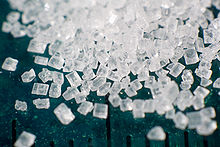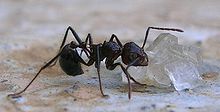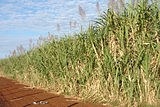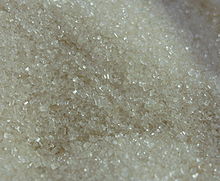- Sugar
-
For other uses, see Sugar (disambiguation).For common table sugar, see Sucrose."White sugar" redirects here. For the Joanne Shaw Taylor album, see White Sugar (album).
 Magnification of grains of refined sucrose, the most common free sugar.
Magnification of grains of refined sucrose, the most common free sugar.
Sugar, granulated Nutritional value per 100 g (3.5 oz) Energy 1,619 kJ (387 kcal) Carbohydrates 99.98 g - Sugars 99.91 g - Dietary fiber 0 g Fat 0 g Protein 0 g Water 0.03 g Riboflavin (vit. B2) 0.019 mg (2%) Calcium 1 mg (0%) Iron 0.01 mg (0%) Potassium 2 mg (0%) Percentages are relative to US recommendations for adults.
Source: USDA Nutrient DatabaseSugars, brown Nutritional value per 100 g (3.5 oz) Energy 1,576 kJ (377 kcal) Carbohydrates 97.33 g - Sugars 96.21 g - Dietary fiber 0 g Fat 0 g Protein 0 g Water 1.77 g Thiamine (vit. B1) 0.008 mg (1%) Riboflavin (vit. B2) 0.007 mg (1%) Niacin (vit. B3) 0.082 mg (1%) Vitamin B6 0.026 mg (2%) Folate (vit. B9) 1 μg (0%) Calcium 85 mg (9%) Iron 1.91 mg (15%) Magnesium 29 mg (8%) Phosphorus 22 mg (3%) Potassium 346 mg (7%) Sodium 39 mg (3%) Zinc 0.18 mg (2%) Percentages are relative to US recommendations for adults.
Source: USDA Nutrient DatabaseSugar is a term for a class of edible crystalline carbohydrates, mainly sucrose, lactose, and fructose,[1] characterized by a sweet flavor. In food, sugars refer to all monosaccharides and disaccharides present in food, but excludes polyols,[2] while in its singular form, sugar normally refers to sucrose, which in its fully refined (or free sugar) form primarily comes from sugar cane and sugar beet, though is present in natural form in many carbohydrates. Other free sugars are used in industrial food preparation, but are usually known by more specific names—glucose, fructose or fruit sugar, high fructose corn syrup, etc.
Currently, Brazil has the highest per capita production of sugar.[3]
Contents
History
Main article: History of sugarSugar has been produced in the Indian subcontinent[4] since ancient times. It was not plentiful or cheap in early times—honey was more often used for sweetening in most parts of the world.
Originally, people chewed sugarcane raw to extract its sweetness. Sugarcane was a native of tropical South Asia and Southeast Asia.[5] Different species likely originated in different locations with Saccharum barberi originating in India and S. edule and S. officinarum coming from New Guinea.[5]
Sugar remained relatively unimportant until the Indians discovered methods of turning sugarcane juice into granulated crystals that were easier to store and to transport.[6] Crystallized sugar was discovered by the time of the Imperial Guptas, around 5th century AD.[6] Indian sailors, consumers of clarified butter and sugar, carried sugar by various trade routes.[6] Traveling Buddhist monks brought sugar crystallization methods to China.[7] During the reign of Harsha (r. 606–647) in North India, Indian envoys in Tang China taught sugarcane cultivation methods after Emperor Taizong of Tang (r. 626–649) made his interest in sugar known, and China soon established its first sugarcane cultivation in the seventh century.[8] Chinese documents confirm at least two missions to India, initiated in 647 AD, for obtaining technology for sugar-refining.[9] In South Asia, the Middle East and China, sugar became a staple of cooking and desserts.
Crusaders brought sugar home with them to Europe after their campaigns in the Holy Land, where they encountered caravans carrying "sweet salt". Early in the 12th century, Venice acquired some villages near Tyre and set up estates to produce sugar for export to Europe, where it supplemented honey as the only other available sweetener.[10] Crusade chronicler William of Tyre, writing in the late 12th century, described sugar as "very necessary for the use and health of mankind".[11]
In August 1492, Christopher Columbus stopped at La Gomera in the Canary Islands, for wine and water, intending to stay only four days. He became romantically involved with the Governor of the island, Beatriz de Bobadilla y Ossorio, and stayed a month. When he finally sailed she gave him cuttings of sugarcane, which became the first to reach the New World.
In 1792, sugar rose to a high price in Great Britain. The East India Company were called upon to help lower the price of sugar. Lieutenant J. Paterson, of the Bengal establishment, reported that sugar-cane could be cultivated in British India with many advantages, and at less expense than in the West Indies. As a result, a number of sugar factories were established in Bihar in British India.[12]
More recently it is manufactured in very large quantities in many countries, largely from sugarcane and sugar beet. In processed foods it has increasingly been supplanted by corn syrup.
Etymology
 Ant feeding on sugar crystals
Ant feeding on sugar crystals
The etymology reflects the spread of the commodity. The English word "sugar"[13] originates from the Arabic word سكر sukkar,[14] itself derived from Sanskrit शर्करा sharkara.[15] It most probably came to England by way of Italian merchants. The contemporary Italian word is zucchero, whereas the Spanish and Portuguese words, azúcar and açúcar respectively, have kept a trace of the Arabic definite article. The Old French word is zuchre - contemporary French sucre. The earliest Greek word attested is σάκχαρη [sákχari].[16] A satisfactory pedigree explaining the spread of the word has yet to be done. Note that the English word jaggery (meaning "coarse brown Indian sugar") has similar ultimate etymological origins (presumably in Sanskrit).
Human health effects
Some studies involving the health impact of sugars are effectively inconclusive. The WHO and FAO meta studies have shown directly contrasting impacts of sugar in refined and unrefined forms [17] and since most studies do not use a population who are not consuming any "free sugars" at all, the baseline is effectively flawed (or as the report puts it, the studies are "limited"). Hence there are articles such as Consumer Reports on Health that said in 2008, "Some of the supposed dietary dangers of sugar have been overblown. Many studies have debunked the idea that it causes hyperactivity, for example."[18] though the article does continue to discuss other health impacts of sugar. Other articles and studies refer to the increasing evidence supporting the links to hyperactivity.[19] The WHO FAO meta-study suggests that such results are expected when some studies do not effectively segregating or controlling for free sugars as opposed to sugars still in their natural form (entirely unrefined) while others do.
Blood glucose levels
Sugar, because of its simpler chemical structure, may raise blood glucose levels more quickly than starch. This finding suggests that this basic differentiation between starch and sugar is insufficient reason to segregate these two substances for controlling blood glucose levels in diabetics, the idea behind carbohydrate counting.[20] A more effective distinction could use that suggested by multiple meta-studies between free sugars and naturally-occurring sugars which do suggest different impacts on health.[17][21]
Obesity and diabetes
Studies appear to conflict with some suggesting eating excessive amounts of sugar does not increase the risk of diabetes, although the extra calories from consuming large amounts of sugar can lead to obesity, which may increase the risk of diabetes,[22][23][23][24][25][26][26][27] while others show links between refined sugar (free sugar) consumption and the onset of diabetes, and negative correlation with the consumption of fibre[28][29][30][31] including a 2010 meta-analysis of eleven studies involving 310,819 participants and 15,043 cases of type 2 diabetes[32] that found that "SSBs [sugar-sweetened beverages] may increase the risk of [metabolic syndrome] and type 2 diabetes not only through obesity but also by increasing dietary glycemic load, leading to insulin resistance, β-cell dysfunction, and inflammation.". As an overview to consumption related to chronic disease and obesity, the World Health Organization's independent meta-studies specifically distinguish free sugars ("all monosaccharides and disaccharides added to foods by the manufacturer, cook or consumer, plus sugars naturally present in honey, syrups and fruit juices") from sugars naturally present in food. The reports prior to 2000 set the limits for free sugars at a maximum of 10% of carbohydrate intake, measured by energy, rather than mass, and since 2002 [17] have aimed for a level across the entire population at less than 10%. The consultation committee recognised that this goal is "controversial. However, the Consultation considered that the studies showing no effect of free sugars on excess weight have limitations." (p57).
Cardiovascular Disease
A number of studies in animals have suggested that chronic consumption of refined sugars can contribute to metabolic and cardiovascular dysregulation. Some experts have suggested that refined fructose is more damaging than refined glucose is more damaging in terms of cardiovascular risk.[33] Cardiac performance has been shown to be impaired by switching from a carbohydrate diet including fibre to a high-carbohydrate diet.[34]
Switching saturated fatty acids for carbohydrates with high glycaemic index values shows a statistically significant positive association with the risk of myocardial infarction.[35]
Other studies have found links between high fat and high glycaemic index carbohydrates accelerates the development of cardiac pathology and pump dysfunction in hypertension despite no signs of diabetes and only a modest level of obesity, suggesting that the link between obesity and coronary heart disease should be shifted towards macronutrients and the high glycaemic load typical of the "junk-food" diet.[36]
The consumption of added sugars has been positively associated with multiple measures known to increase cardiovascular disease risk amongst adolescents as well as adults.[37]
Studies are suggesting the impact of refined carbohydrates or high glycaemic load carbohydrates are more significant that the impact of saturated fatty acids on cardiovascular disease.[38][39]
High level of sugar (in this case, sucrose or disaccharide) consumption can substantially increase the risk for heart- and vascular diseases. According to a new Swedish study from Lund University and Malmö University College of 4301 persons, sugar was associated with higher levels of bad blood fat with a high level of small and medium LDL and reduced HDL blood fat. However the amount of fat intake didn't affect the blood fats. As a side note, moderate quantities of alcohol and protein were linked to the good HDL blood fat.[40]
Macular Degeneration
There are links between free sugar consumption and macular degeneration in older age.[41]
Tooth decay
In regard to contributions to tooth decay, the role of free sugars is also recommended to be below an absolute maximum of 10% of energy intake, with a minimum of zero. There is "convincing evidence from human intervention studies, epidemiological studies, animal studies and experimental studies, for an association between the amount and frequency of free sugars intake and dental caries" while other sugars (complex carbohydrate) consumption is normally associated with a lower rate of dental caries.[21] Lower rates of tooth decay have been seen in individuals with hereditary fructose intolerance.[42]
Terminology
Popular
The term sugar usually refers to sucrose, which is also called "table sugar" or "saccharose." Sucrose is a white crystalline disaccharide. It is often obtained from sugar cane or sugar beet.[43] Sucrose is the most popular of the various sugars for flavoring, as well as properties (such as mouthfeel, preservation, and texture) of beverages and food.
Chemical
"Sugar" can also be used to refer to water-soluble crystalline carbohydrates with varying sweetness. Sugars include monosaccharides (e.g., glucose, fructose, galactose), disaccharides (e.g., sucrose, lactose, maltose), trisaccharides, and oligosaccharides,[44] in contrast to complex carbohydrates such as polysaccharides. Corn syrup, dextrose, crystalline fructose, and maltose, for example, are used in manufacturing and preparing food.
Baking weight/mass volume relationship
Different culinary sugars have different densities due to differences in particle size and inclusion of moisture.
The Domino Sugar Company has established the following volume to weight conversions:
- Brown sugar 1 cup = 48 teaspoons ~ 195 g = 6.88 oz
- Granular sugar 1 cup = 48 teaspoons ~ 200 g = 7.06 oz
- Powdered sugar 1 cup = 48 teaspoons ~ 120 g = 4.23 oz
Bulk density[45]
- Dextrose sugar 0.62 g/mL
- Granulated sugar 0.70 g/mL
- Powdered sugar 0.56 g/mL
- Beet sugar 0.80 g/mL
Purity standards
The International Commission for Uniform Methods of Sugar Analysis sets standards for the measurement of the purity of refined sugar, known as ICUMSA numbers; lower numbers indicate a higher level of purity in the refined sugar.[46]
Chemistry
Main article: CarbohydrateScientifically, sugar loosely refers to a number of carbohydrates, such as monosaccharides, disaccharides, or oligosaccharides. Monosaccharides are also called "simple sugars," the most important being glucose. Almost all sugars have the formula CnH2nOn (n is between 3 and 7). Glucose has the molecular formula C6H12O6. The names of typical sugars end with "-ose," as in "glucose", "dextrose", and "fructose". Sometimes such words may also refer to any types of carbohydrates soluble in water. The acyclic mono- and disaccharides contain either aldehyde groups or ketone groups. These carbon-oxygen double bonds (C=O) are the reactive centers. All saccharides with more than one ring in their structure result from two or more monosaccharides joined by glycosidic bonds with the resultant loss of a molecule of water (H2O) per bond.
Monosaccharides in a closed-chain form can form glycosidic bonds with other monosaccharides, creating disaccharides (such as sucrose) and polysaccharides (such as starch). Enzymes must hydrolyse or otherwise break these glycosidic bonds before such compounds become metabolised. After digestion and absorption. the principal monosaccharides present in the blood and internal tissues include glucose, fructose, and galactose. Many pentoses and hexoses can form ring structures. In these closed-chain forms, the aldehyde or ketone group remains unfree, so many of the reactions typical of these groups cannot occur. Glucose in solution exists mostly in the ring form at equilibrium, with less than 0.1% of the molecules in the open-chain form.
Natural polymers of sugars
Biopolymers of sugars are common in nature. Through photosynthesis plants produce glucose, which has the formula C6H12O6, and convert it for storage as an energy reserve in the form of other carbohydrates such as starch, or (as in cane and beet) as sucrose (table sugar). Sucrose has the chemical formula C12H22O11. Starch, consisting of two different polymers of glucose, is a readily degradable chemical energy stored by cells, convertible to other types of energy.
Cellulose is a polymer of glucose used by plants as structural component.
DNA and RNA are built up of the sugars ribose and deoxyribose. The sugar in DNA is deoxyribose, and has the formula C5H10O4.
See also
- Barley sugar
- Biobutanol
- Brown sugar
- Caramel
- Glycomics
- Holing cane
- List of unrefined sweeteners
- Saccharophilic pathogen
- Sugar alcohol
- Sugarloaf
- Sugar plantations in the Caribbean
- Sugar substitute
References
- ^ "IUPAC Gold Book - sugars". Goldbook.iupac.org. 2009-09-07. http://goldbook.iupac.org/S06088.html. Retrieved 2009-12-20.
- ^ Union, European (1990). "Council Directive on nutrition labeling for foodstuffs". pp. 4. http://eur-lex.europa.eu/LexUriServ/LexUriServ.do?uri=CONSLEG:1990L0496:20081211:EN:PDF. Retrieved 2011-09-28
- ^ International sugar statistics http://www.illovosugar.com/World_of_sugar/Sugar_Statistics/International.aspx
- ^ Moxham, Roy, The Great Hedge of India, Carroll & Graf, 2001.
- ^ a b "Sharpe, Peter (1998). Sugar Cane: Past and Present. Illinois: Southern Illinois University.". http://www.siu.edu/~ebl/leaflets/sugar.htm.
- ^ a b c Adas, Michael (January 2001). Agricultural and Pastoral Societies in Ancient and Classical History. Temple University Press. ISBN 1566398320. Page 311.
- ^ Kieschnick, John (2003). The Impact of Buddhism on Chinese Material Culture Princeton University Press. ISBN 0691096767.
- ^ Sen, Tansen. (2003). Buddhism, Diplomacy, and Trade: The Realignment of Sino-Indian Relations, 600–1400. Manoa: Asian Interactions and Comparisons, a joint publication of the University of Hawaii Press and the Association for Asian Studies. ISBN 0824825934. Pages 38–40.
- ^ Kieschnick, John (2003). The Impact of Buddhism on Chinese Material Culture Princeton University Press. 258. ISBN 0691096767.
- ^ Ponting, Clive (2000) [2000]. World history: a new perspective. London: Chatto & Windus. p. 481. ISBN 0-701-16834-X.
- ^ Barber, Malcolm (2004). The two cities: medieval Europe, 1050-1320 (2nd ed.). Routledge. p. 14. ISBN 9780415174152. http://books.google.com/?id=7Kkm7cgT_xkC&pg=PA14&dq=%22very+necessary+for+the+use+and+health+of+mankind%22&q=%22very%20necessary%20for%20the%20use%20and%20health%20of%20mankind%22.
- ^ http://www.bihargatha.in/early-agriculture-based-enterprenureships/sugar-concerns
- ^ The -g- is unexplained, possibly reflecting a Venetian dialect.
- ^ Compare the OED and the Online Etymology Dictionary.
- ^ Ahmad Y Hassan, Transfer Of Islamic Technology To The West, Part III: Technology Transfer in the Chemical Industries, History of Science and Technology in Islam.
- ^ This form is not phonetically explained, but may reflect a mediation through a language en route from the Sanskrit original. Modern Greek ζάχαρη [sáχari] is due to cluster simplification [kχ] > [χ] and initial sandhi (acc. την σάχαρη [tin sáχari] > τη ζάχαρη [ti záχari]). The word has also changed its nominal class.
- ^ a b c Joint WHO/FAO Expert Consultation, 2003, "WHO Technical Report Series 916 Diet, Nutrition and the Prevention of Chronic Diseases", Geneva
- ^ "Shaking salt and sugar from your diet". Consumer Reports on Health. Consumers Union of U.S.. January 2008. http://www.consumerreports.org/health/healthy-living/diet-nutrition/diets-dieting/shaking-salt-and-sugar-from-your-diet-1-08/overview/salt-and-sugar-ov.htm. Retrieved July 22, 2011. For example, a 1995 meta-analysis of 23 studies, in: Wolraich, ML et al. (November 22, 1995). "The Effect of Sugar on Behavior or Cognition in Children". Journal of the American Medical Association 20: 1617–1621. doi:10.1001/jama.1995.03530200053037. http://jama.ama-assn.org/content/274/20/1617.abstract. Retrieved 29 July 2011.
- ^ Lars Lien, MD, MSc, Nanna Lien, PhD, Sonja Heyerdahl, PhD, Magne Thoresen, PhD and Espen Bjertness, PhD (October 2006). "Consumption of Soft Drinks and Hyperactivity, Mental Distress, and Conduct Problems Among Adolescents in Oslo, Norway". American Journal of Public Health 96 (10): 1815–1820. doi:10.2105/AJPH.2004.059477. PMC 1586153. PMID 17008578. http://www.pubmedcentral.nih.gov/articlerender.fcgi?tool=pmcentrez&artid=1586153. and Leila Azadbakht Ph.D., Ahmad Esmaillzadeh Ph.D. (2011). "Dietary patterns and attention deficit hyperactivity disorder among Iranian children". Nutrition (Science Direct). doi:10.1016/j.nut.2011.05.018. and Caroline Davis (2010). "Attention-deficit/Hyperactivity Disorder: Associations with Overeating and Obesity". Current Psychiatry Reports 12 (5): 389–395. doi:10.1007/s11920-010-0133-7. PMID 20632134.
- ^ Beaser, Richard S.; Campbell, Amy P. (2005). The Joslin guide to diabetes: a program for managing your treatment (2nd ed.). Simon and Schuster. p. 37. ISBN 9780743257848. http://books.google.com/?id=mbE62ijFyrQC&pg=PA37.
- ^ a b Diet, nutrition and the prevention of dental diseases, Public Health Nutrition: 7(1A), 201–226
- ^ American Association of Clinical Endocrinologists. “Diabetes Quiz.” Last Modified 2007-07-11.
- ^ a b American Dietetic Association. “Nutrition: Fact vs. Fiction.”
- ^ Joslin Diabetes Center. “Classroom Presentation on Diabetes for Elementary School Age Children.”
- ^ Marschilok, Catherine. “Ask a Medical Professional: Diabetes Myths and Misconceptions.” Juvenile Diabetes Research Foundation.
- ^ a b American Diabetes Association. “Diabetes Myths.”
- ^ National Diabetes Education Program. “Tips for Teens with Diabetes.” Last Modified November 2007.
- ^ "Sugar-Sweetened Soft Drinks, Obesity, and Type 2 Diabetes", Caroline M. Apovian, MD, The Journal of the American Medical Association, 2004;292(8):978-979. doi: 10.1001/jama.292.8.978
- ^ "Increased consumption of refined carbohydrates and the epidemic of type 2 diabetes in the United States: an ecologic assessment", Lee S Gross, Li Li, Earl S Ford and Simin Liu, American Journal of Clinical Nutrition, Vol. 79, No. 5, 774-779, May 2004
- ^ "Genetic and environmental determinants of type II diabetes in Mexico City and San Antonio", M P Stern, C Gonzalez, B D Mitchell, E Villalpando, S M Haffner and H P Hazuda, Diabetes April 1992 vol. 41 no. 4 484-492
- ^ "Carbohydrate quantity and quality and risk of type 2 diabetes in the European Prospective Investigation into Cancer and Nutrition–Netherlands (EPIC-NL) study", Ivonne Sluijs, Yvonne T van der Schouw, Daphne L van der A, Annemieke M Spijkerman, Frank B Hu, Diederick E Grobbee, and Joline W Beulens, The American Journal of Clinical Nutrition, August 4, 2010, doi: 10.3945/ajcn.2010.29620
- ^ Vasanti S. Malik et al., 2010, "Sugar-Sweetened Beverages and Risk of Metabolic Syndrome and Type 2 Diabetes: A meta-analysis", Diabetes Care 33(11), 2477-2483. http://care.diabetesjournals.org/content/33/11/2477.full?sid=25e775f0-e2cd-4094-823e-214acf07dea8
- ^ Sugary drinks in the pathogenesis of obesity and cardiovascular diseasesSugar-sweetened drinks, C M Brown, A G Dulloo and J-P Montani, International Journal of Obesity 32, S28-S34 (December 2008) | doi:10.1038/ijo.2008.204
- ^ Carbohydrate-enriched diet impairs cardiac performance by decreasing the utilization of fatty acid and glucose, Laura C.J. Pôrto, Sílvia S.Q. Savergnini, Carlos H. de Castro, Érica G. Mario, Adaliene V.M. Ferreira, Sérgio H.S. Santos, Sílvia P. Andrade, Robson A.S. Santos, Alvair P. de Almeida, Leida M. Botion, Ther Adv Cardiovasc Dis February 2011 vol. 5 no. 1 11-22, doi: 10.1177/1753944710386282
- ^ Intake of carbohydrates compared with intake of saturated fatty acids and risk of myocardial infarction: importance of the glycemic index, Marianne U Jakobsen, Claus Dethlefsen, Albert M Joensen, Jakob Stegger, Anne Tjønneland, Erik B Schmidt, Kim Overvad, Am J Clin Nutr June 2010 vol. 91 no. 6 1764-1768, doi: 10.3945/ ajcn.2009.29099
- ^ Does Junk Food Lead to Heart Failure? Importance of Dietary Macronutrient Composition in Hypertension, William C. Stanley, Keyur B. Shah, M. Faadiel Essop, Hypertension. 2009; 54: 1209-1210, doi: 10.1161/ HYPERTENSIONAHA.109.128660
- ^ Consumption of Added Sugars and Indicators of Cardiovascular Disease Risk Among US Adolescents, Jean A. Welsh, PhD, MPH, RN; Andrea Sharma, PhD, MPH; Solveig A. Cunningham, PhD; Miriam B. Vos, MD, MSPH, American Heart Association, 2011; 123: 249-257, January 10, 2011, doi: 10.1161/ CIRCULATIONAHA.110.972166
- ^ Saturated fat, carbohydrate, and cardiovascular disease, Patty W Siri-Tarino, Qi Sun, Frank B Hu, Ronald M Krauss, American Society for Nutrition, January 20, 2010, doi: 10.3945/ ajcn.2008.26285; Am J Clin Nutr March 2010 vol. 91 no. 3 502-509, doi: 10.3945/ ajcn.2008.26285
- ^ Are refined carbohydrates worse than saturated fat?, Frank B Hu, The American Journal of Clinical Nutrition, June 2010 vol. 91 no. 6 1541-1542, doi: 10.3945/ ajcn.2010.29622
- ^ cambridge.org - British Journal of Nutrition, High disaccharide intake associates with atherogenic lipoprotein profile
- ^ Diet High in Refined Carbohydrates May Increase Risk for Age-Related Macular Degeneration, Laurie Barclay, MD, American Journal of Clinical Nutrition, 2007;86:1210–1218
- ^ Zero DT, Fontana M, Martínez-Mier EA, Ferreira-Zandoná A, Ando M, González-Cabezas C, Bayne S (September 2009). "The biology, prevention, diagnosis and treatment of dental caries: scientific advances in the United States". J Am Dent Assoc 140: 25S–34S. PMID 19723928. http://jada.ada.org/cgi/reprint/140/suppl_1/25S.
- ^ "Sugar" in Dictionary.com Unabridged.
- ^ "Sugar." Merriam-Webster Online Dictionary. 2010.
- ^ ""Engineering Resources - Bulk Density Chart," Powder and Bulk". http://www.powderandbulk.com/resources/bulk_density/material_bulk_density_chart_s.htm.
- ^ Deulgaonkar, Atul (March 12–25, 2005). "A case for reform". Frontline 22 (8). http://www.hinduonnet.com/fline/fl2208/stories/20050422000804500.htm.
Further reading
- Adas, Michael (January 2001). Agricultural and Pastoral Societies in Ancient and Classical History. Temple University Press. ISBN 1566398320. OCLC 44493265.
- James, Glyn (2004). Sugarcane. Blackwell Publishing. ISBN 063205476X. OCLC 84251137 51837990 84251137.
- A C Hannah, The International Sugar Trade, Cambridge: Woodhead, 1996. ISBN 1-85573-069-3
- Aurora A. Saulo (March 2005). "Sugars and Sweeteners in Foods". College of Tropical Agriculture and Human Resources. http://www.ctahr.hawaii.edu/oc/freepubs/pdf/FST-16.pdf.
- Gary Taubes (April 13, 2011). "Is sugar toxic?". New York Times. http://www.nytimes.com/2011/04/17/magazine/mag-17Sugar-t.html?pagewanted=1&_r=1&src=ISMR_HP_LO_MST_FB.
External links
Types of carbohydrates General: Geometry Monosaccharides Aldodiose (Glycolaldehyde)Ketopentose (Ribulose, Xylulose)
Aldopentose (Ribose, Arabinose, Xylose, Lyxose)
Deoxy sugar (Deoxyribose)Ketoheptose (Sedoheptulose, Mannoheptulose)>7Multiple Other oligosaccharidesGlucose/Glucan: Glycogen · Starch (Amylose, Amylopectin) · Cellulose · Dextrin/Dextran · Beta-glucan (Zymosan, Lentinan, Sizofiran) · Maltodextrin
Fructose/Fructan: Inulin · Levan beta 2→6
N-Acetylglucosamine: Chitinbiochemical families: prot · nucl · carb (glpr, alco, glys) · lipd (fata/i, phld, strd, gllp, eico) · amac/i · ncbs/i · ttpy/i
Wikimedia Foundation. 2010.




